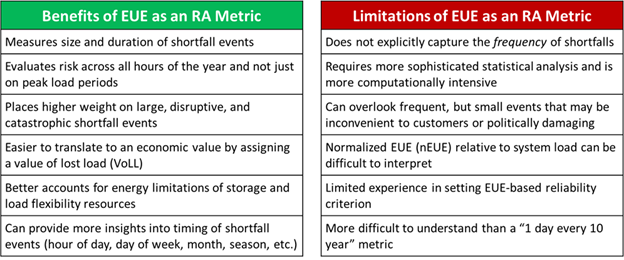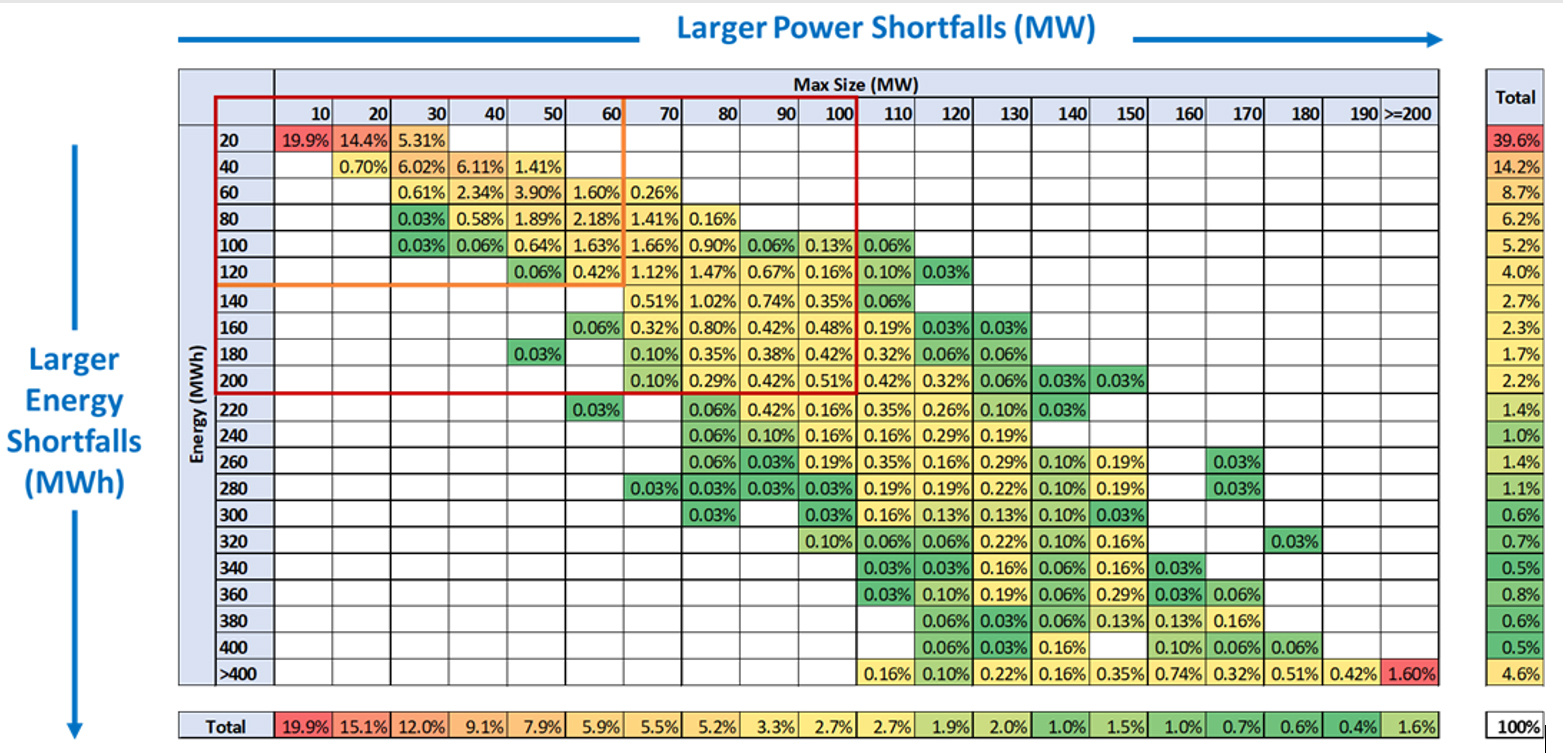ESIG recently released a report titled Redefining Resource Adequacy for Modern Power Systems, which laid a foundation for new ways to think about resource adequacy and reliability as the grid decarbonizes. In that work, we laid out six principles to guide changes to the way we consider and quantify resource adequacy in an era of decarbonization. This blog post expands on that work with a specific focus on metrics. These metrics ultimately determine how we measure risk, make investment decisions, and decide whether to retire generation. While resource adequacy metrics may seem opaque and nebulous to many—four recommendations for improved resource adequacy metrics can help ensure we make sound investment decisions during the energy transition.

Derek Stenclik
Significant improvements can be made using the framework we already have today. This post does not call for novel metrics, new calculations, or a fundamental change in the way we measure reliability. We can, and should, leverage existing metrics better—to provide more information, details, and insight to grid planners. This ensures not only that we maintain reliability for a changing resource mix, but also that we invest in the right resources—ones that are specifically tailored to meet the reliability needs of today, and the future.
Recommendation #1: Place More Emphasis on Expected Unserved Energy
The use of loss of load expectation (LOLE)—the mainstay of North American resource adequacy planning—as a single reliability criterion is of limited, and diminishing, value for system planning. LOLE is an opaque metric when used in isolation for a 1-day-in-10-years reliability criterion. It only provides a measure of average amount of shortfalls over a study period and does not characterize the magnitude or duration of specific outage events.
As the power system increasingly relies on variable renewable energy and energy-limited resources for reliability, the grid will be less power constrained and more energy constrained. For example, shortfalls may be caused by sustained lulls in wind and solar generation and subsequent depletion of storage, rather than random outages of thermal generators. Another example is an extreme cold snap that simultaneously disrupts gas supply, causes the failure of generating equipment, and leads to increased heating loads and electricity demand. Such correlated events can cascade into a large shortfall that affects a substantial portion of the load. Expected unserved energy (EUE), which measures the average amount of energy shortfalls—as opposed to just the number of shortfalls—allows resource adequacy analysis to clearly differentiate these events from more typical short-duration shortfalls.
The figure below provides an overview of both the benefits and limitations of EUE as a planning metric. While increased use of EUE may not be perfect, it is likely preferable to current practice.
Figure 1. Benefits and Limitations of EUE as a Resource Adequacy Metric

Source: Energy Systems Integration Group
Recommendation #2: Use a Suite of Reliability Metrics, Not Just One
While the previous recommendation calls for increased use of EUE to measure resource adequacy, there is no need to be confined to a single metric. No metric is perfect, and the use of multiple metrics can illuminate different aspects of system risk.
Take, for example, the rolling blackouts experienced in California during August 2020 and those experienced in Texas in February 2021. Both were resource adequacy events, but they are characterized very differently depending on the metric used. On a days-of-shortfall basis (LOLE), the California and Texas events are somewhat similar (two and three days, respectively), but when using LOLH or EUE, there is a clear difference. LOLH shows the California and Texas events to be 6 hours and 71 hours, respectively, and EUE shows a difference of 2,700 MWh and 990,000 MWh. The dramatic discrepancies in the measurements by LOLH and EUE show how overreliance on a single metric can skew the characterization of an event and have serious implications for decision-making around mitigation.
Table 1. Resource Adequacy Metric Comparison Between the California and Texas Reliability Events

Source: Energy Systems Integration Group
Recommendation #3: Move Beyond Expected Values
A limitation of all of the resource adequacy metrics discussed above is that they are all expected values. While resource adequacy analysis may evaluate thousands of random samples, the results are averaged and reported as a single value representing all randomized years of simulation. However, overreliance on single point, average metrics can cause planners to miss outlier tail events.
Resource adequacy analysis is analogous to an insurance policy in that we voluntarily incur an expense that only delivers a service in rare, often extreme circumstances. Planners, regulators, and ratepayers are accustomed to paying a premium for surplus capacity resources that are available to operate only on rare occasions. However, insurance covers a range of reliability events from average events to worst-case scenarios and tail events. In contrast, resource adequacy currently deals only with averages, hindering its ability to protect the system against a wide range of events, including very-low-probability events with severe consequences.
There is precedence for planning that takes into account both an average resource adequacy metric as well as a tail end risk. For example, Belgium uses a two-part reliability criterion on LOLH which takes into account both an average LOLH criterion (3 hours/year) and an LOLH95 criterion (20 hours/year), which makes sure there are enough resources to cover a statistically abnormal year.
Recommendation #4: Characterize the Size, Frequency, Duration, and Timing of Shortfall Events
Perhaps the most important recommendation, and also the easiest to implement in the short term, is to characterize the size, frequency, duration, and timing of shortfall events. This can be done using improved analysis of existing metrics and employing certain visualization techniques. Doing so provides important information on the distribution of events and places emphasis on individual, rather than aggregate, event characteristics. Relying on multiple metrics and visualizations of the size, frequency, duration, and timing of shortfall events will allow planners to select mitigations and resources that are appropriately sized to fit system needs identified and avoid over-procurement of resources.
This requires moving away from single-point metrics to look at broad sets of data. Take the following chart, which summarizes resource adequacy shortfalls to better capture the size, magnitude, and duration of events, as an example. The columns of data summarize shortfalls by the maximum MW unserved, per event. The rows of data summarize the total energy unserved in each individual event. Information embedded in the chart can help size the appropriate mitigation—whether it is energy storage, demand response, load flexibility, or thermal resources. There are several other examples of data summaries and visualizations that can better characterize the underlying resource adequacy need.

Figure 2: Characterizing the Percent of Loss of Load Hours by MW and MWh
Where Do We Go from Here?
Resource adequacy metrics may seem confusing and opaque to many in the industry, but they are used as the foundation of many investment decisions. As the power system’s resource mix changes, the metrics and reliability criteria used by system planners must also evolve. Increased utilization of energy-limited resources and variable renewable energy means that we need resource adequacy metrics that measure size, frequency, duration, and timing of shortfall events. With increased energy limitations on the resource mix, a metric that explicitly tracks unserved energy is desirable. Today, the best option is increased emphasis on EUE as a reliability criterion.
It is too early to tell whether entirely new metrics need to be developed, but what is certain is that planners can and should extract more information and details from existing calculations. For the time being, as electricity system stakeholders, we need to roll up our sleeves and do the hard analytical work. What we learn will help us develop heuristics and new rules to make resource adequacy analysis easier and less costly to conduct and simple to understand. But for now, we must rely on in-depth analysis on real systems and better use of resource adequacy metrics.
Derek Stenclik
Telos Energy

Leave a Reply